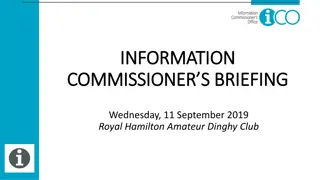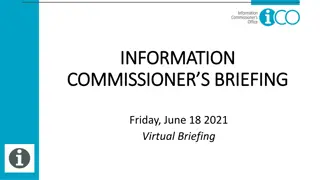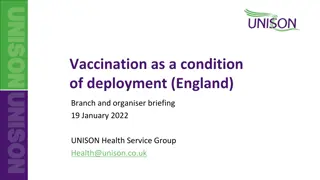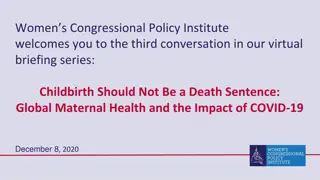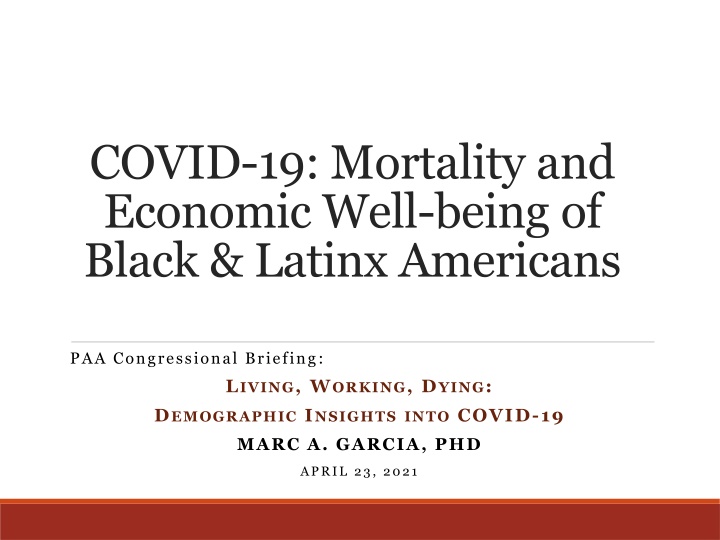
Insights into COVID-19 Impact on Black & Latinx Americans
Explore demographic insights into the mortality and economic well-being of Black and Latinx Americans during the COVID-19 pandemic. This data-driven briefing covers mortality rates, economic hardships, and disparities in healthcare outcomes among different racial and ethnic groups.
Download Presentation

Please find below an Image/Link to download the presentation.
The content on the website is provided AS IS for your information and personal use only. It may not be sold, licensed, or shared on other websites without obtaining consent from the author. If you encounter any issues during the download, it is possible that the publisher has removed the file from their server.
You are allowed to download the files provided on this website for personal or commercial use, subject to the condition that they are used lawfully. All files are the property of their respective owners.
The content on the website is provided AS IS for your information and personal use only. It may not be sold, licensed, or shared on other websites without obtaining consent from the author.
E N D
Presentation Transcript
COVID-19: Mortality and Economic Well-being of Black & Latinx Americans PAA Congressional Briefing: LIVING, WORKING, DYING: DEMOGRAPHIC INSIGHTS INTO COVID-19 MARC A. GARCIA, PHD APRIL 23, 2021
Collaborators Rogelio Saenz, University of Texas-San Antonio Adriana M. Reyes, Cornell University Amy Thierry, Xavier University
Data COVID DATA Tracker Deaths by Age and Race/Ethnicity
Ratio of Non-White AADRs to White AADRs for COVID-19 and Non-COVID-19 Deaths 3.00 2.40 2.50 1.90 2.00 1.50 1.30 1.00 0.77 0.50 0.00 Latinx-White COVID-19 Deaths Black-White Non-COVID-19 Deaths
COVID-19 Death Ratio by Age Group and Race/Ethnicity, per 100,000 Population Latinx-White Black-White 6.0 5.5 4.8 5.0 4.7 4.5 4.3 3.9 4.0 3.6 3.5 3.5 3.4 3.2 3.1 2.9 3.0 2.6 2.6 2.5 2.1 1.8 2.0 1.3 1.2 1.0 0.0 0-4 5-14 15-24 25-34 35-44 45-54 55-64 65-74 75-84 85+
Percentage Distribution of U.S. COVID-19 Deaths by Age for Black, Latinx and White Americans, January 1, 2020 to April 3, 2021 100% 90% 80% 70% 63.5 72.9 60% 88.6 50% 40% 30% 26.1 20% 20.8 10% 9.6 10.4 1.8 6.3 0% Latinx Non-Latinx Black Non-Latinx White Less than 50 50-64 65 and Older
COVID-19 and Economic Well-being
Data Nationally representative study of older adults ages 50 and older in the United States. 2020 HRS COVID-19 Project Data V1 (Nov. 2020 Release). Administered to the 50% random subsample of households (3,266 respondents). Originally assigned to enhanced face-to-face interviewing (EFTF). Two random half groups; starting in June and September, respectively.
HRS COVID-19 Module 60% 55.6% 48.7% 50% 40% 32.9% 33.0% 30.1% 28.3% 30% 26.0% 24.7% 20.7% 20% 17.8% 15.7% 13.1% 10% 0% Income Decreased Household Spending Increased 1 or More Economic Hardships White Black US-Born Latinx Foreign-Born Latinx
HRS COVID Module 30% 27.8% 26.1% 25% 19.9% 20% 17.9% 18.0% 16.8% 16.8% 16.0% 15.9% 15% 9.4% 10% 8.8% 8.5% 8.6% 8.3% 8.3% 7.9% 7.7% 7.7% 5.4% 5% 3.9% 3.6% 3.7% 2.5% 2.2% 0% Missed Rent/ Mortgage Missed Debt Payments Missed Utilities/ Insurance Payments US-Born Latinx Couldn t Pay Medical Bills Lacked Money for Food Trouble Buying Food with Money White Black Foreign-Born Latinx
Structural Racism: The Root Cause of the Social Determinants of Health Access to health care Access to resources Education Employment Environment Income/Poverty Insurance Coverage Housing Racism Discrimination Segregation Transportation
Structural Racism: The Root Cause of the Social Determinants of Health Barriers to quality healthcare: Unequal availability of diagnostic and treatment resources Uneven distribution of specialty care Limited health care workforce diversity Limited language services Barriers to healthcare access: Gaps in health insurance coverage Challenges travelling to in-person services Limited availability of telehealth resources HEALTH DISPARITIES Missed or delayed diagnoses Missed or delayed treatments Increased morbidity Increased mortality
Future Directions: Intersection of Health, Place & Equity Healthcare facilities Access to Healthy Food Schools/ Childcare Health Community Safety/ Violence Housing Environment Equity Parks/Open Green Spaces Transportation Work environments
Contact Information: Marc A. Garc a marcagarcia@unl.edu









